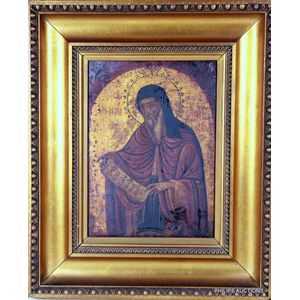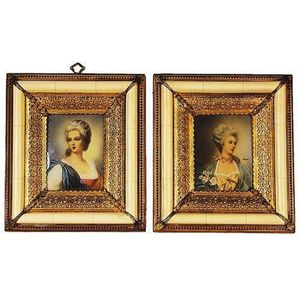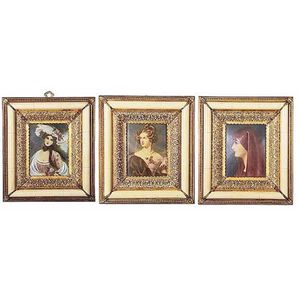18th Century Ladies Miniature Portrait Set in Gilt Frame
You must be a subscriber, and be logged in to view price and dealer details.
Subscribe Now to view actual auction price for this item
When you subscribe, you have the option of setting the currency in which to display prices to $Au, $US, $NZ or Stg.
- Ivory - Ivory is a hard white material that comes from the tusks of elephants, mammoth, walrus and boar, or from the teeth of hippopotamus and whales. The ivory from the African elephant is the most prized source of ivory. Although the mammoth is extinct, tusks are still being unearthed in Russia and offered for sale.
Ivory has been used since the earliest times as a material for sculpture of small items, both in Europe and the east, principally China and Japan.
In Asia ivory has been carved for netsuke, seals, okimono, card cases, fan supports, animals and other figures and even as carved tusks.
In the last 200 years in Europe ivory has been used to carve figures, for elaborate tankards, snuff boxes, cane handles, embroidery and sewing accessories, in jewellery and as inlay on furniture. Its more practical uses include being used for billiard balls, buttons, and a veneers on the top of piano keys.
The use and trade of elephant ivory have become controversial because they have contributed to Due to the decline in elephant populations because of the trade in ivory, the Asian elephant was placed on Appendix One of the Convention on International Trade in Endangered Species (CITES), in 1975, and in January 1990, the African elephant was similarly listed. Under Appendix One, international trade in Asian or African elephant ivory between member countries is forbidden. Unlike trade in elephant tusks, trade in mammoth tusks is legal.
Since the invention of plastics, there have been many attempts to create an artificial ivory - Filigree Work - Decorative Arts - Delicate decorations using fine threads of ceramics, glass or other materials to give a lace-like effect, attached together and applied as an ornament.
This item has been included into following indexes:
-
miniatures
- 18th century 88
- Georgian 230
- portrait and other 1,173
- sets or collections 146
Visually similar items

A Greek orthodox Russian icon, painted with Christ (Pantokrator), 'The Almighty' with halo to his head, his right hand raised with finger and thumb touching, gilt enrichments. 19.5 x 14.5 cm, later gilt frame

An Orthodox icon of a Prophet or apostle with a scroll, probably 17th century, in gesso and gilt upon a prepared timber panel depicting a white bearded figure with a red cloak and nimbus holding an open scroll, with church Slavonic script to the scroll and

Minature hand painted pair of portraits in a gilt filigree frame surrounded by rounded ivory panels depictings 18th century ladies, one signed 'Silver', the other indistinctly signed. Dimensions of each 17 x 15 cm

Three framed hand coloured engravings, prints of originals dated circa 1765, by John Hill. Certificates of Authenticity from Discovery, Noosa, Queensland, available. 38 cm X 23 cm (average)
